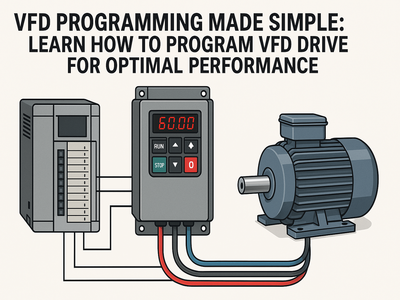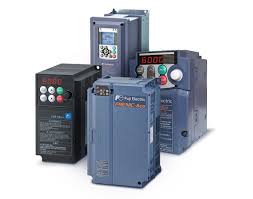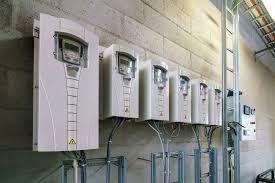Introduction to VFD Programming
VFD programming is the key to controlling the speed and efficient running of a motor in the world of industrial automation. The full form of VFD is Variable Frequency Drive, which is essential to change the frequency as well as voltage to be given to electric motors. So, what is it exactly for VFD in electrical systems? It is a unit that helps you in controlling a variable-speed AC motor, using which your motor performs great and uses minimal energy.
Through the use of VFD programming, industries save energy, improve process control, and extend the life of motor-driven equipment. Before implementation, knowledge of VFD working principle and the types of VFD is mandatory..
Understanding the VFD Working Principle
The crux of VFD working principle is converting fixed-frequency AC power into variable-frequency AC power. Three major processes comprise this one: the VFD controller, the VFD electrical circuitry, and the VFD inverter. If you follow the working principle of a VFD drive, it allows the accurate management of the speed and torque of the motor. It also reduces part wear and increases efficiency.
A VFD controller controls the amount of voltage and frequency of the electrical power provided to the motor and allows the operator to control motor speed and torque. This tech is prevalent in industries like production, HVAC (heating, ventilation, and air-conditioning) systems, and water treatment plants.
Key Applications of VFD Programming
There are many VFD applications in a diverse range of industries, including manufacturing, HVAC systems, and water treatment plants. Utilizing various forms of VFD, such as voltage-source and current-source inverter types, optimum motor results can be achieved. A VFD should be connected properly, as well as set up to work together with the motor.
Some common applications include:
- Conveyor systems
- Pumps and fans
- Compressors
- Industrial mixers
- HVAC systems
VFD programming in each of these applications facilitates precise speed control, energy savings, and reduced wear on equipment.
Step-by-Step Guide to VFD Programming
- VFD programming basics: Understanding the parameters and settings
- Programming VFD drives for acceleration, deceleration, and torque control
- Accessing the VFD programming manual for in-depth configuration
- Implementing Lenze VFD programming for advanced applications
- Integrating VFD PLC programming for automated control systems
To begin, operators must access the VFD programming manual to understand the specific settings required for their application. This includes setting the acceleration and deceleration rates, torque limits, and fault protection parameters. For more advanced control, Lenze VFD programming offers additional customization options.
Advanced VFD Programming Techniques
- Custom VFD programming in PLC environments for real-time monitoring
- Fine-tuning motor speed and torque with VFD function settings
- Hands-on VFD programming training for mastering advanced control strategies
Advanced techniques involve integrating VFD PLC programming for seamless automation. By programming the VFD directly within a PLC environment, operators can achieve precise motor control and monitor performance in real time.
Troubleshooting and Maintenance
- Analyzing errors in VFD drive working
- Preventive maintenance and firmware updates
- Diagnosing issues with VFD connection and electrical faults
Common issues in VFD drives include overheating, incorrect parameter settings, and electrical faults. Regular maintenance, firmware updates, and proper VFD connections can help prevent these issues and ensure smooth operation.
Future Trends in VFD Programming
The future of VFD programming is driven by IoT integration and predictive analytics. With smart VFD systems, remote monitoring and energy optimization are becoming more efficient. Advanced technologies like AI-driven automation further enhance motor control and productivity.
Emerging trends include:
- Cloud-based VFD monitoring
- Predictive maintenance using machine learning
- Integration with renewable energy systems
Conclusion
There are numerous sophisticated features built into a VFD that should ideally be programmed properly in order to make the motor run efficiently and to save on energy. As a result, knowing the VFD working principle, VFD PLC programming, and Lenze VFD programming helps a company set up automation effortlessly while also saving overhead costs. VFD programming training prepares operators with the skills required to set up and troubleshoot VFD systems successfully.
Unlock the full potential of your industrial automation with expert VFD programming solutions. Aknitech offers top-notch VFD programming training, Lenze VFD programming, and VFD PLC programming support. Visit aknitech.in for customized solutions and take your automation to the next level!







